Method of Designing a Friction-Based Wedge Anchorage System for High-Strength CFRP Plates
Abstract
:1. Introduction
2. Theoretical Analysis
2.1. Anti-Slip Mechanism
2.2. Stress Redistribution Mechanism
2.3. Factors Influencing Anchorage Efficiency Coefficient
3. Determination of Parameters
4. Finite element analysis
5. Static Tensile Test
5.1. Experimental program
5.2. Results and Discussion
6. Conclusions
Author Contributions
Funding
Institutional Review Board Statement
Informed Consent Statement
Data Availability Statement
Acknowledgments
Conflicts of Interest
References
- Karam, E.C.; Hawileh, R.A.; El Maaddawy, T.; Abdalla, J.A. Experimental investigations of repair of pre-damaged steel-concrete composite beams using CFRP laminates and mechanical anchors. Thin-Walled Struct. 2017, 112, 107–117. [Google Scholar] [CrossRef]
- Zhu, W.; Li, M.; Qin, H.; Fu, F.; Liu, F. Behavior of RC Beams Strengthened Using Steel-Wire-Carbon-Fiber-Reinforced Plates. Materials 2020, 13, 3996. [Google Scholar] [CrossRef] [PubMed]
- Drissi-Habti, M.; Yanev, B.; Betti, R. Suspension Bridge Cables: Pathologies, Inspection, Alternative Materials. Mater. Eval. 2009, 67, 1379–1386. [Google Scholar]
- Drissi-Habti, M.; Betti, R.; Bojidar, Y. Structural Health Monitoring of Bridge Cables. Mater. Eval. 2009, 67, 1285–1292. [Google Scholar]
- Puigvert, F.; Crocombe, A.D.; Gil, L. Static analysis of adhesively bonded anchorages for CFRP tendons. Constr. Build. Mater. 2014, 61, 206–215. [Google Scholar] [CrossRef] [Green Version]
- Meier, U. Carbon fiber reinforced polymer cables: Why? Why not? What if? Arab. J. Sci. Eng. 2012, 37, 399–411. [Google Scholar] [CrossRef] [Green Version]
- Wang, L.C.; Zhang, J.Y.; Xu, J.; Han, Q. Anchorage systems of CFRP cables in cable structures—A review. Constr. Build. Mater. 2018, 160, 82–99. [Google Scholar] [CrossRef]
- Hong, S.; Park, S.K. Effect of prestress levels on flexural and debonding behavior of reinforced concrete beams strengthened with prestressed carbon fiber reinforced polymer plates. J. Compos. Mater. 2013, 47, 2097–2111. [Google Scholar] [CrossRef]
- Li, W.J. Study on Carbon Fiber Reinforced Polymer Parallel-Plate Cables and Corrugated-Plate Anchorage; Tsinghua University: Beijing, China, 2016. [Google Scholar]
- Xie, G.H.; Tang, Y.S.; Wang, C.M.; Li, S.Q.; Liu, R.G. Experimental study on fatigue performance of adhesively bonded anchorage system for CFRP tendons. Compos. Part B Eng. 2018, 150, 47–59. [Google Scholar] [CrossRef] [Green Version]
- Wang, X.; Xu, P.C.; Wu, Z.S.; Shi, J. A Novel Anchor Method for Multitendon FRP Cable: Manufacturing and Experimental Study. J. Compos. Constr. 2015, 19, 04015010. [Google Scholar] [CrossRef]
- Al-Mayah, A.; Soudki, K.; Plumtree, A. Mechanical behavior of CFRP rod anchors under tensile loading. J. Compos. Constr. 2001, 5, 128–138. [Google Scholar] [CrossRef]
- Campbell, T.L.; Shrive, N.G.; Soudki, K.A.; Al-Mayah, A.; Keatley, J.P.; Reda, M.M. Design and evaluation of a wedge-type anchor for FRP tendons. Can. J. Civ. Eng. 2000, 27, 985–992. [Google Scholar] [CrossRef]
- Wu, G.; Zhao, X.; Zhou, J.; Wu, Z. Experimental Study of RC Beams Strengthened with Prestressed Steel-Wire BFRP Composite Plate Using a Hybrid Anchorage System. J. Compos. Constr. 2015, 19, 04014039. [Google Scholar] [CrossRef]
- Li, C.G.; Xian, G.J. Novel wedge-shaped bond anchorage system for pultruded CFRP plates. Mater. Struct. 2018, 51, 1–14. [Google Scholar] [CrossRef]
- Li, C.G.; Xian, G.J. Design optimization and experimental validation of a novel wedge-shaped bond anchorage system for prestressed CFRP plates. Polym. Test. 2019, 75, 167–174. [Google Scholar] [CrossRef]
- Zhu, W.X.; Shao, L.; Wang, Y. Finite element analysis and test of wedge-type anchor for prestressed CFRP plates. Earthq. Resist. Eng. Retrofit. 2015, 37, 97–101. [Google Scholar]
- Mohee, F.M.; Al-Mayah, A.; Plumtree, A. Development of a novel prestressing anchor for CFRP plates: Experimental investigations. Compos. Struct. 2017, 176, 20–32. [Google Scholar] [CrossRef]
- Wu, J.Y.; Xian, G.J.; Li, H. A novel anchorage system for CFRP cable: Experimental and numerical investigation. Compos. Struct. 2018, 194, 555–563. [Google Scholar] [CrossRef]
- Zhu, J.L.; Yang, W.R. The experiment of CFRP rods and epoxy mortar bond behavior in different environment. Sci. Technol. Eng. 2016, 16, 265–269. [Google Scholar]
- Yang, L. Research on Carbon Fiber Cable Anchorage and the Influence of Water Immersion Environment on Its Fatigue Performance; Guilin University of Technology: Guilin, China, 2020. [Google Scholar]
- Mohee, F.M.; Al-Mayah, A.; Plumtree, A. Anchors for CFRP plates: State-of-the-art review and future potential. Compos. Part B Eng. 2016, 90, 432–442. [Google Scholar] [CrossRef]
- Ghafoori, E.; Motavalli, M. Innovative CFRP-prestressing system for strengthening metallic structures. J. Compos. Constr. 2015, 19, 04015006. [Google Scholar] [CrossRef]
- Ghafoori, E.; Motavalli, M.; Nussbaumer, A.; Herwig, A.; Prinz, G.S.; Fontana, M. Design criterion for fatigue strengthening of riveted beams in a 120-year-old railway metallic bridge using pre-stressed CFRP plates. Compos. Part B Eng. 2015, 68, 1–13. [Google Scholar] [CrossRef]
- Wu, Z.S.; Iwashita, K.; Niu, H.D. Study on Strengthening Technique with Prestressed PBO Fiber Sheets. Eng. Sci. 2005, 9, 18–24. (In Chinese) [Google Scholar]
- Kojima, T.; Takagi, N.; Hamada, Y.; Kobayashi, A. Flexural Strengthening of RC Beams by Using the Tensioned CFRP Plate. In Proceedings of the first fib congress 2002, Concrete Structures in the 21st Century, Osaka, Japan, 13–19 October 2002; Volume 1, pp. 39–40. [Google Scholar]
- Ye, H.W.; Zhang, Q.; Liu, C.M.; Wu, C.; Duan, Z. Failure mechanisms governing anchoring force of friction-based wedge anchorage for prestressed CFRP plate. Compos. Struct. 2019, 225, 111142. [Google Scholar] [CrossRef]
- Ye, H.; Liu, C.; Hou, S.; Wang, T.; Li, X. Design and experimental analysis of a novel wedge anchor for prestressed CFRP plates using pre-tensioned bolts. Compos. Struct. 2018, 206, 313–325. [Google Scholar] [CrossRef]
- Mohee, F.M.; Al-Mayah, A. Effect of Modulus of Elasticity and Thickness of the CFRP plate on the Performance of a Novel Anchor for Structural Retrofitting and Rehabilitation Applications. Eng. Struct. 2017, 153, 302–316. [Google Scholar] [CrossRef]
- Mohee, F.M.; Al-Mayah, A. Effect of barrel, wedge material and thickness on composite plate anchor performance through analytical, finite element, experimental and 3D prototype investigations. Eng. Struct. 2018, 175, 138–154. [Google Scholar] [CrossRef]
- Schmidt, J.W.; Bennitz, A.; Täljsten, B.; Goltermann, P.; Pedersen, H. Mechanical anchorage of FRP tendons–A literature review. Constr. Build. Mater. 2012, 32, 110–121. [Google Scholar] [CrossRef]
- Ronaldf, G. Principles of Composite Materials Mechanics-Dekker Mechanical Engineering; CRC Press: Boca Raton, FL, USA, 2007. [Google Scholar]
- Sun, C.T. Mechanics of Aircraft Structures; John Wiley & Sons: Hoboken, NJ, USA, 2006. [Google Scholar]
- Tsai, S.W.; WUE, M. A general theory of strength for anisotropic materials. J. Compos. Mater. 1971, 5, 58–80. [Google Scholar] [CrossRef]
- Huang, Z.N. Determination of Friction Parameters for Carbon Fiber Reinforced Anchorage Structure; Guilin University of Technology: Guilin, China, 2020. [Google Scholar]
- Meng, Y.C.; Wang, Y.H.; Jing, R.; Zhang, R.T.; Zhang, X.G. Study of antiskid and wear-resistant coatings of marine engineering composites. Paint Coat. Ind. 2020, 50, 67–71. [Google Scholar]
- GB/T 14370-2015 Anchorage, Grip and Coupler for Prestressing Tendons; Standards Press of China: Beijing, China, 2015.
- Ye, H.W.; Wu, C.J.; Liu, D.J.; Wang, T.; Zhang, Q. Friction and wear behavior of CFRP plate in contact with roughened mould steel under high normal pressure. Constr. Build. Mater. 2019, 220, 308–319. [Google Scholar] [CrossRef]

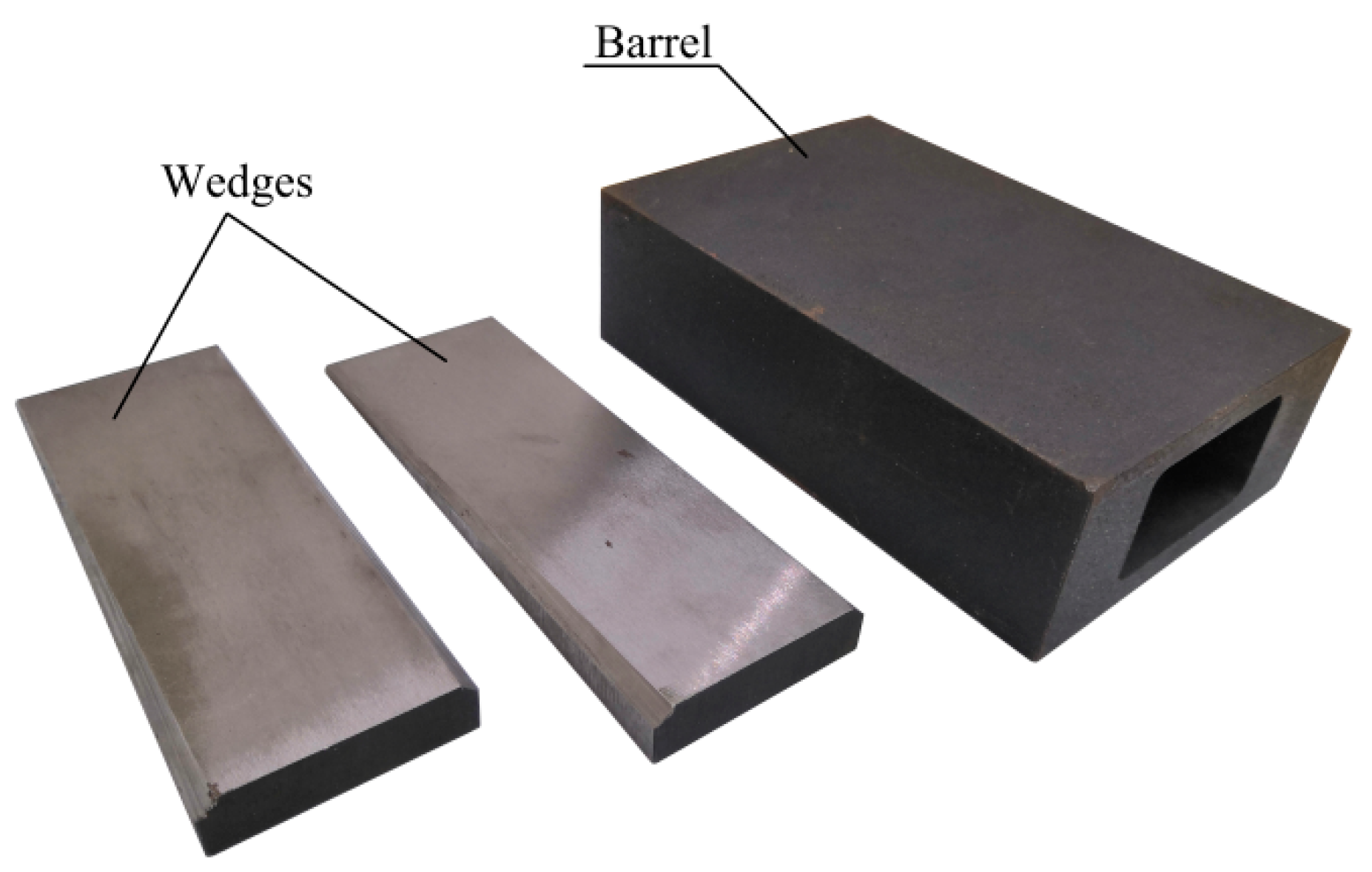



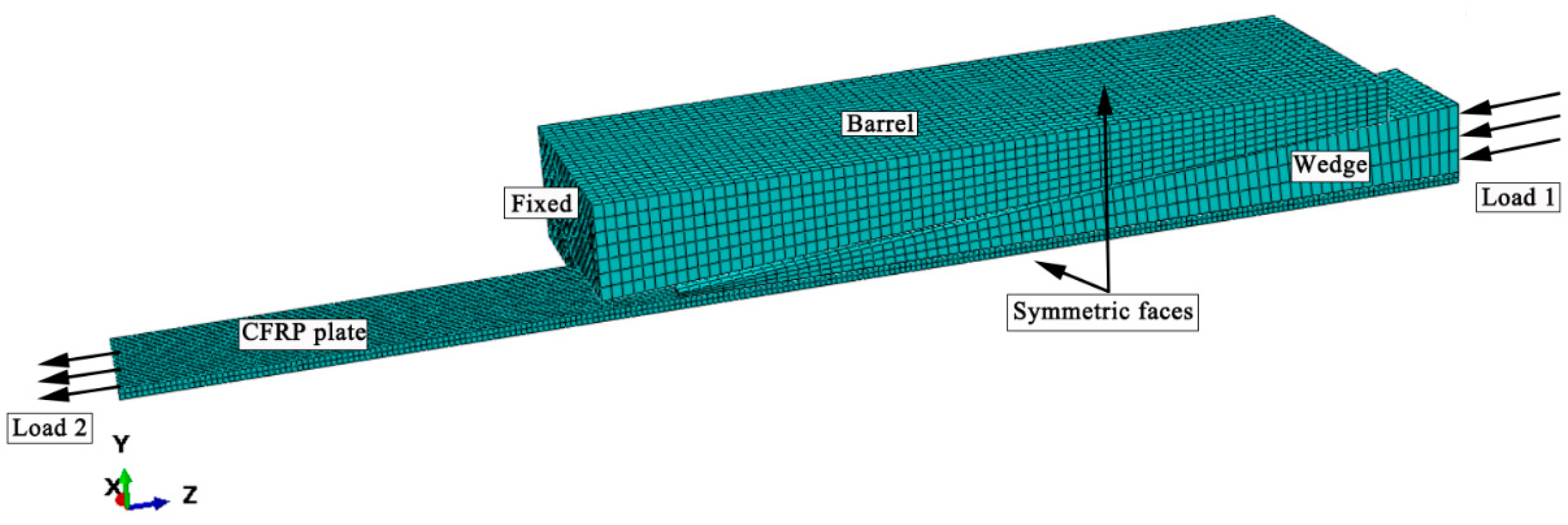
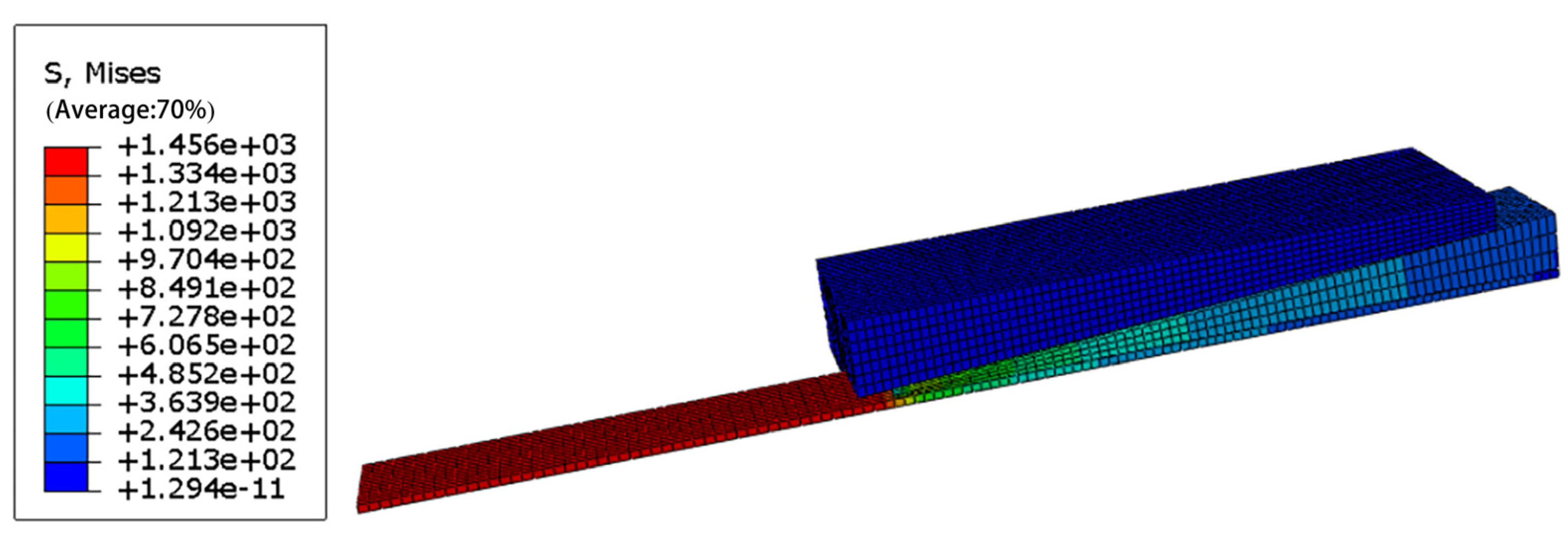
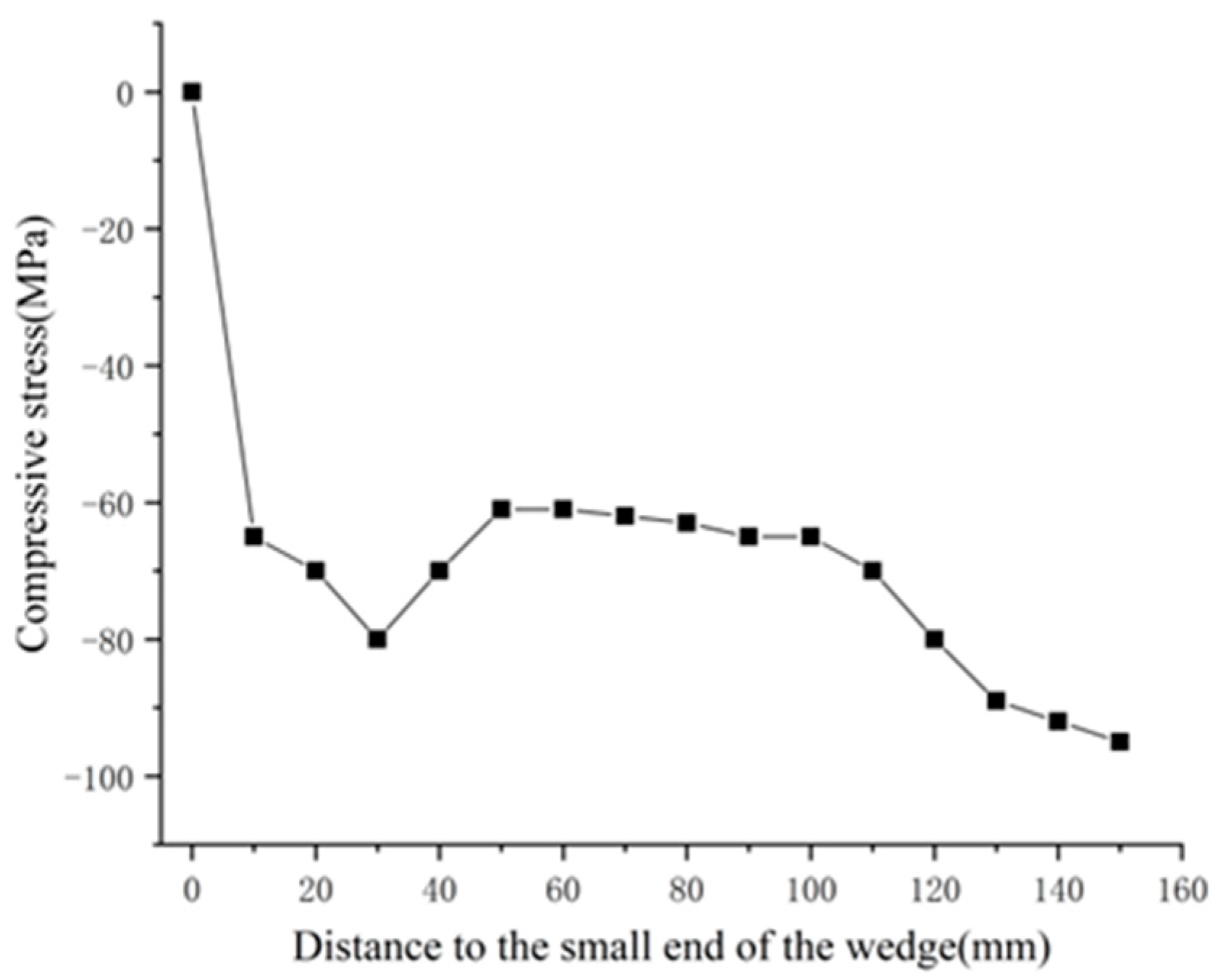


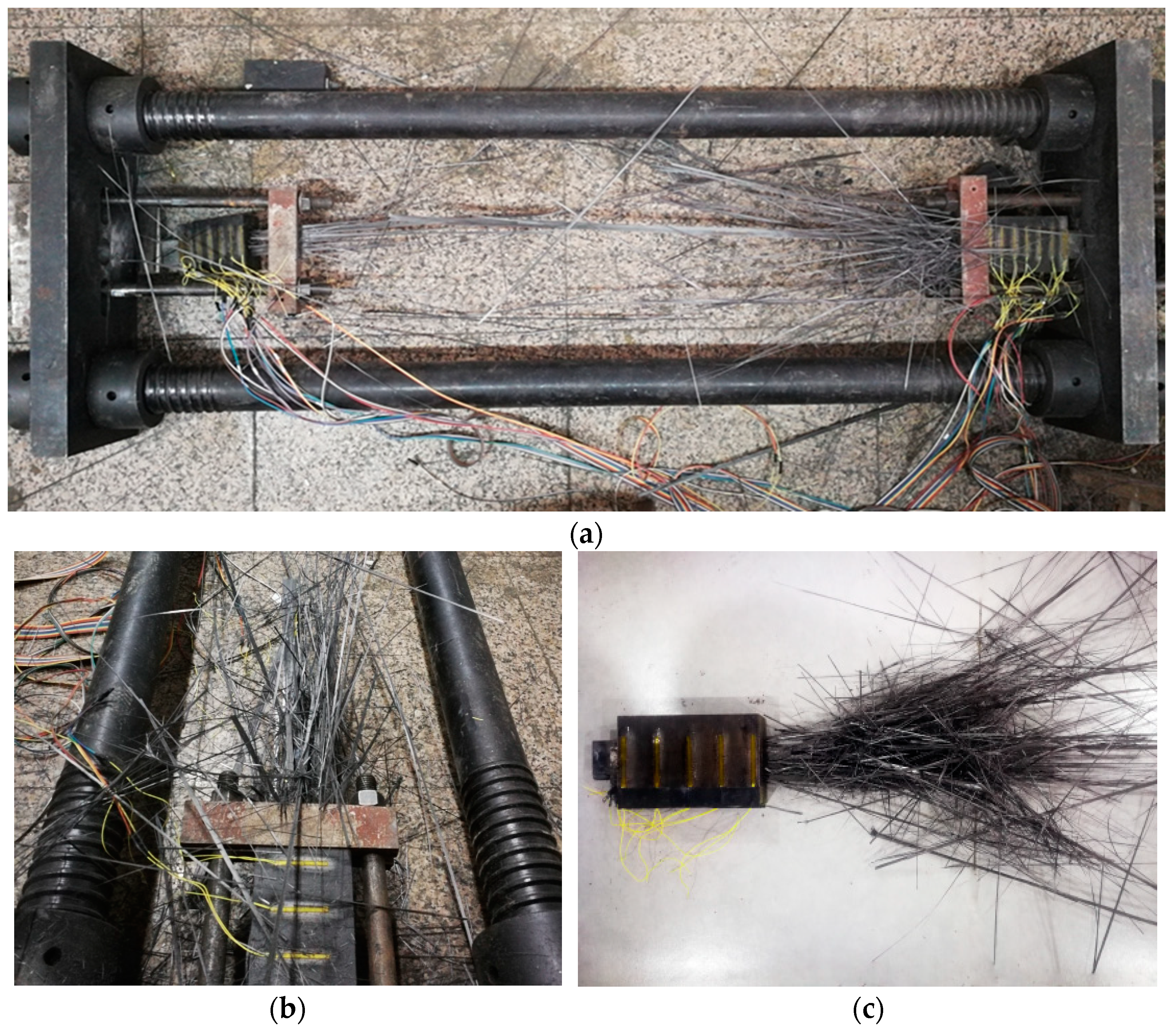
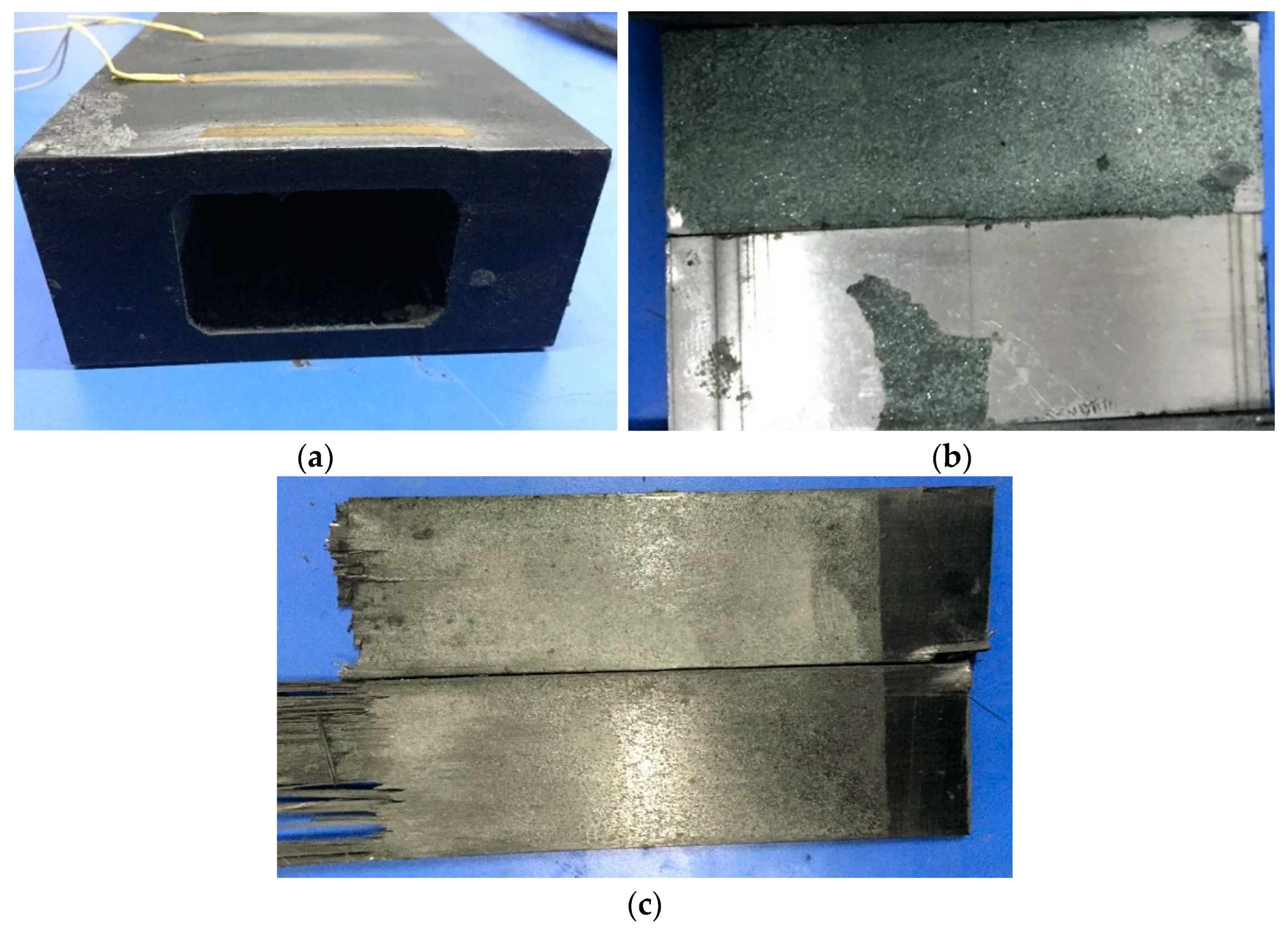
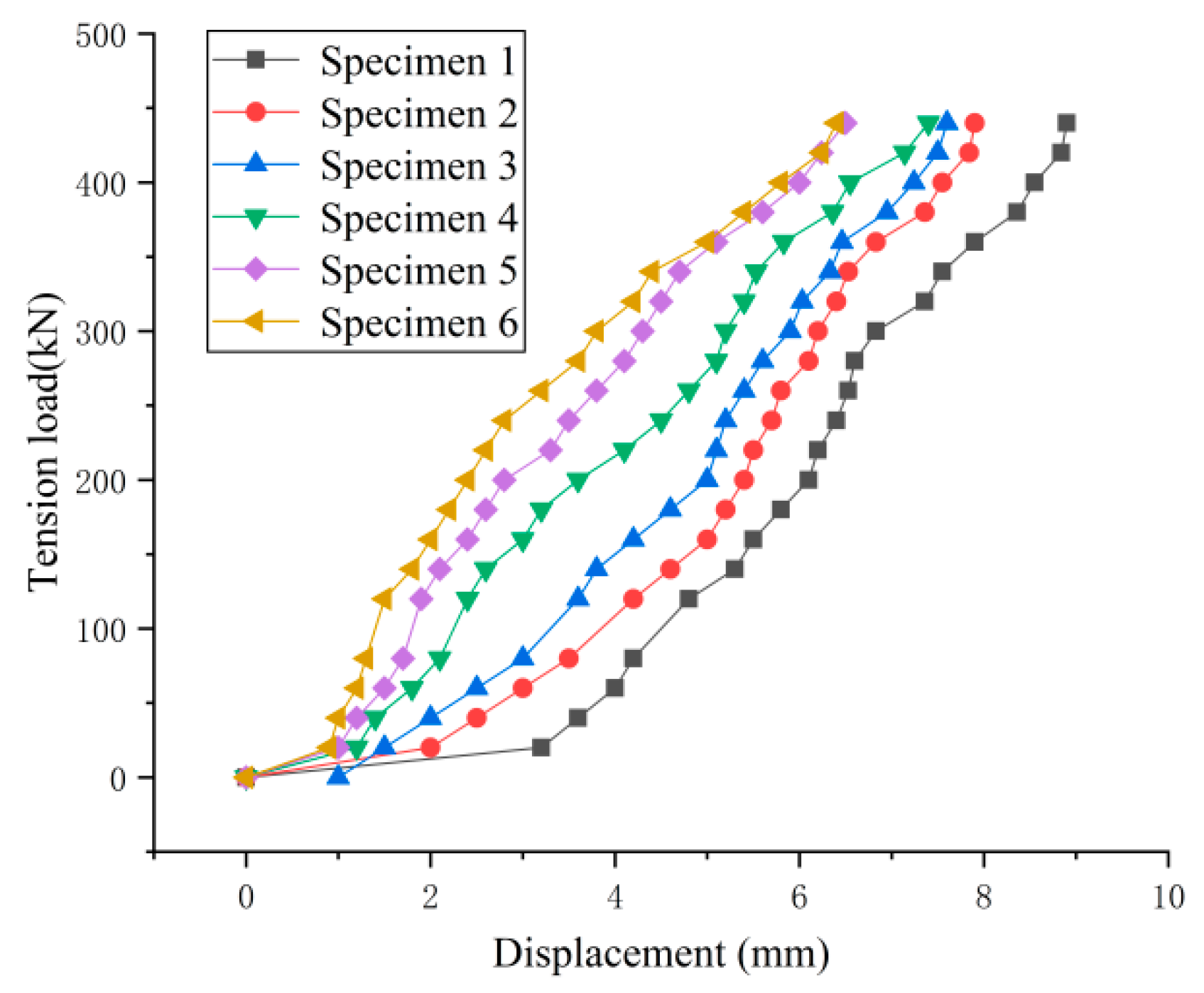
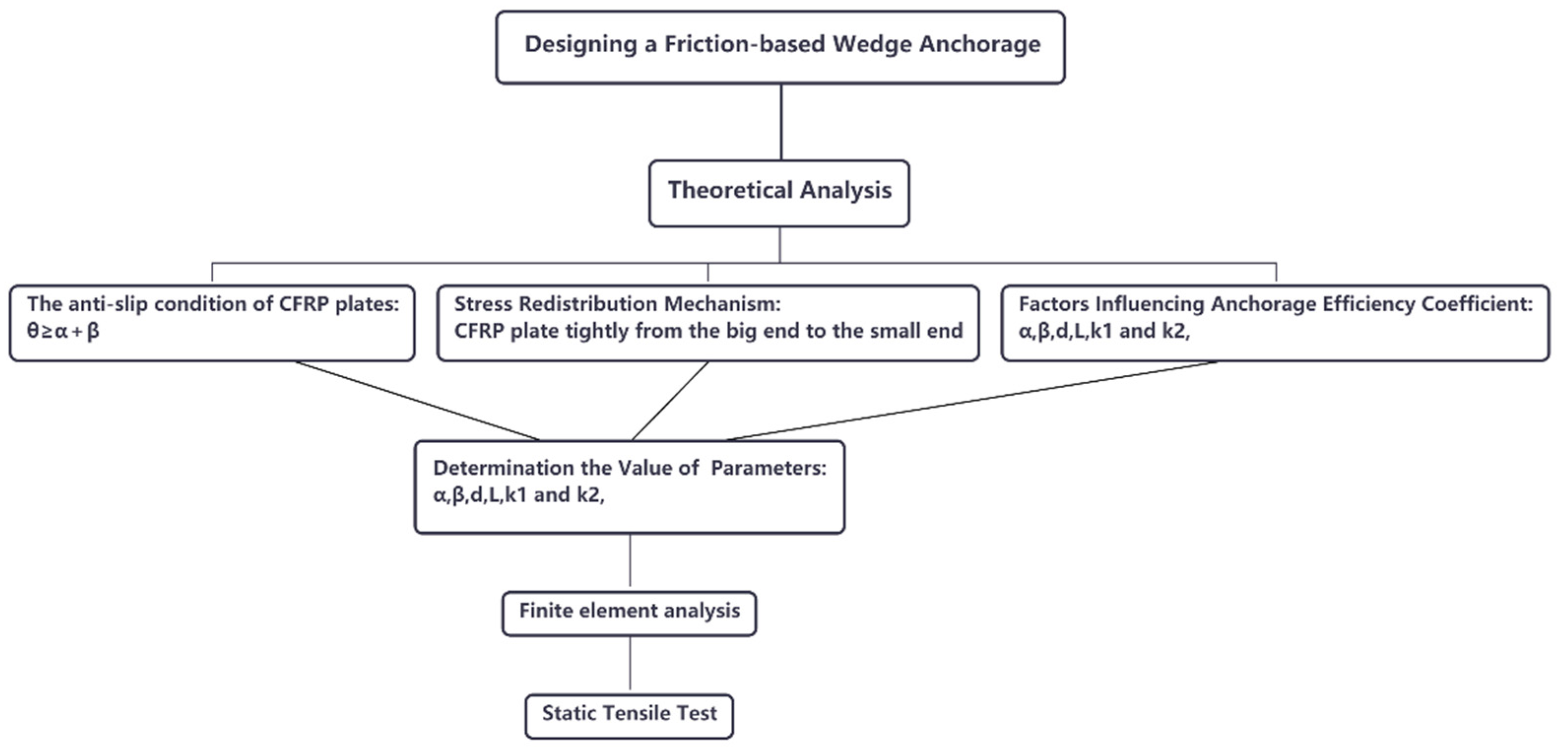
| Width of CFRP Plate (mm) | Thickness of CFRP Plate (mm) | Minimum Anchorage Length (mm) |
|---|---|---|
| 50 | 1.2 | 67 |
| 2 | 98 | |
| 3 | 147 | |
| 4 | 196 |
| Component | Maximum von Mises stress (MPa) |
|---|---|
| Barrel | 694.12 |
| Wedge | 573.20 |
| CFRP plate | 1456.33 |
| Specimen No. | Lubricant on Interface 2 | Failure Mode | Failure Stress of Carbon Plate(MPa) | Anchorage Efficiency Coefficient |
|---|---|---|---|---|
| 1 | No | Breaking of fiber yarns | 2256.0 | 0.940 |
| 2 | Yes | Breaking of fiber yarns | 2281.0 | 0.950 |
| 3 | Yes | Breaking of fiber yarns | 2300.5 | 0.958 |
| 4 | Yes | Breaking of fiber yarns | 2326.5 | 0.969 |
| 5 | Yes | Breaking of fiber yarns | 2313.0 | 0.964 |
| 6 | Yes | Breaking of fiber yarns | 2350.5 | 0.979 |
Publisher’s Note: MDPI stays neutral with regard to jurisdictional claims in published maps and institutional affiliations. |
© 2021 by the authors. Licensee MDPI, Basel, Switzerland. This article is an open access article distributed under the terms and conditions of the Creative Commons Attribution (CC BY) license (https://creativecommons.org/licenses/by/4.0/).
Share and Cite
Zhu, W.; Wei, W.; Liu, F.; Zeng, R. Method of Designing a Friction-Based Wedge Anchorage System for High-Strength CFRP Plates. Materials 2021, 14, 6443. https://doi.org/10.3390/ma14216443
Zhu W, Wei W, Liu F, Zeng R. Method of Designing a Friction-Based Wedge Anchorage System for High-Strength CFRP Plates. Materials. 2021; 14(21):6443. https://doi.org/10.3390/ma14216443
Chicago/Turabian StyleZhu, Wanxu, Wei Wei, Fengrong Liu, and Rong Zeng. 2021. "Method of Designing a Friction-Based Wedge Anchorage System for High-Strength CFRP Plates" Materials 14, no. 21: 6443. https://doi.org/10.3390/ma14216443
APA StyleZhu, W., Wei, W., Liu, F., & Zeng, R. (2021). Method of Designing a Friction-Based Wedge Anchorage System for High-Strength CFRP Plates. Materials, 14(21), 6443. https://doi.org/10.3390/ma14216443





